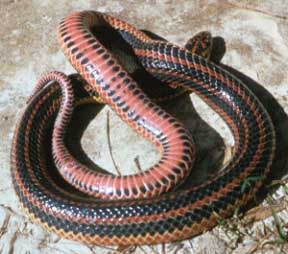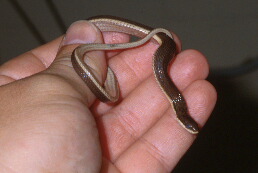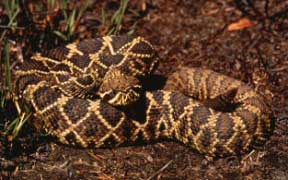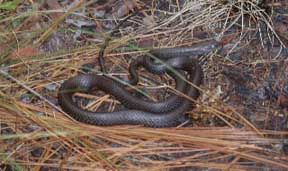General Misconceptions About Snakes
Skin
Many
people who are unfamiliar with snakes assume that their skin is cold and
slimy. The skin of a snake is actually dry and scaly. In many
instances, the skin of snakes is smooth to the touch. The scales
that make up a reptile's skin consist of keratin, the same material that
makes up human fingernails, mammal hair, and bird feathers, none of which
are slimy.
Just like the skin of humans,
a snake's skin can either be warm or cold. If a snake is retrieved
from a hibernaculum or caught beside a cold body of water it is likely
that its skin will be cold. However, a snake caught on a warm afternoon
while basking in the sun will usually feel as warm as any mammal.
Unlike mammals, which are endotherms, amphibians and reptiles are ectothermic
which means that their body temperature is usually dependent on the immediate
surroundings. |
Rainbow Snake (Farancia erytrogramma)

photo credit: Steve Mullin |
Size
Snakes are often reported
as being much longer than they actually are. The nearly universal
long and narrow body design of snakes makes it easy to overestimate their
length. The fact that many snakes often remain in a coiled position
may also lead to false estimations of their size. In addition, overestimates
of their size by humans may undoubtedly be attributed to fear. The
majority of snakes in North Carolina range from 1-3 feet in length.
Some active-foraging snakes such as coachwhips
and
ratsnakes
may reach lengths of up to 7 feet. By far, the largest bodied snake
in the southeastern United States is the eastern
diamondback rattlesnake. Besides having broad, thick bodies,
these snakes can attain lengths of up to 8 feet, although such lengths
are uncommon.
Queen Snake
(Regida septemvittata)
Size: 15-24 inches

|
Eastern
Diamondback Rattlesnake (Crotalus adamanteus)
Size: 3-8 feet

photo credit: Steve Bennett |
Speed
Another common misconception
about snakes concerns the speeds at which they travel. Many people
believe that snakes are very fast. In reality, few snakes are able
to travel over 6 mph. The manner in which many snakes travel, lateral
undulation, gives the illusion that they are traveling faster than they
really are. Another reason snakes may appear to be traveling faster
than they really are is that they are more adept to traveling through dense
cover due to their lean profile. |
Black Racer(Coluber
constrictor)

|
Venomous Snakes
The regularity
with which people kill snakes may lead one to believe that the world is
overrun with venomous snakes. In fact, venomous snakes only make
up about 10 percent of snake species worldwide. There are six species
of venomous snakes in North Carolina compared to thirty-one species of
nonvenomous snakes. Five of the six local venomous species are pit
vipers and belong to the family Viperidae. Local snakes belonging
to the family Viperidae include the copperhead,
cottonmouth,
timber
rattlesnake, eastern
diamondback rattlesnake, and the
pigmy rattlesnake. The remaining local venomous species is the
eastern
coral snake which belongs to the cobra family (family: Elapidae).
Of the six species of venomous snakes in North Carolina, three are considered
to be uncommon or rare in most areas (eastern diamondback, pigmy rattlesnake,
and the coral snake).
Aggressiveness
One commonly
held misconception is that snakes are aggressive and chase people.
Herpetologists, people who study amphibians and reptiles and frequently
encounter snakes, never seem to report being chased by them. When
confronted by a human, a snake is more likely to attempt to escape rather
than attack. This is not to say that some snakes will not defend
themselves. If an escape route is not available, some snakes will
advance towards a disturber in hopes of driving them away. What many
people fail to realize is that snakes have nothing to gain from chasing
a person. No snake in the United States is capable of eating a person.
It is therefore unreasonable to believe that any snake is targeting a human
as a potential meal. Finally, snakes are not vengeful animals and
do not chase people out of sheer hate.




